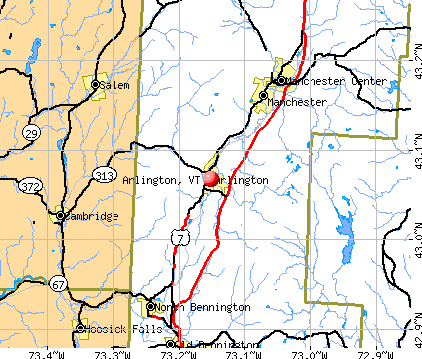Arlington (Vermont)
Bennington County
50-01450
Arlington is a town in Bennington County in the U.S. state of Vermont with 2,317 inhabitants ( U.S. Census 2010). Arlington is located between the Taconic Mountains and the Green Mountains. The most important river is the Batten Kill, on whose banks the main settlement of the municipality, Arlington Village lies.
The town was proclaimed a settlement on July 28, 1761 by the Governor of New Hampshire, Benning Wentworth, as part of the New Hampshire Grants. First meeting of the purchaser, in which the systematic cultivation of the area was discussed and decided to found in 1862 in the nearby community of Pownal instead. Most of the new owner never settled on the acquired land, so a premium for the first ten settlers was decided at the first meeting in the new Town, which took place on June 1, 1763, who settled in Arlington. For 1763 only four permanently colonizing the Town families are known, a first larger number of settlers could only be in Frühjahr1764 down here. At the same time, a grain and a sawmill were built. By 1780, the settlement ran away continuously so that no later than this time there was a stable community.
In the summer of 1764 the young community was that of the British king's decision, that the goods sold through New Hampshire regions to the colony of New York should include charged. Among the mostly poor settlers led the desire of New York, to sell them their land again, as the sale by New Hampshire had been unlawful to strong rejection of the new administration; There were raids of New York militia and armed resistance. The unrest escalated over several years. The attempted arrest of the commune Remember Baker by New York's troops on March 22, 1772 led to open violence; she was one of the reasons for establishing an organized counter- militia, the Green Mountain Boys under Ethan Allen, who eventually won the independence of the entire disputed territory from 1776 under the name Vermont Republic. Among the later leaders of the Green Mountain Boys and the Vermont Republic, a considerable number at the time of these operations were located in Arlington. These included among others, Seth Warner, one of the leading players in the Green Mountain Boys and the War of Independence, and Thomas Chittenden, first president of the Vermont Republic.
A first wooden church was in 1784, at the same time a first community cemetery was established. This church was replaced by a decision of the Municipal Assembly 1829-1830 by a stone. This building still exists today, the St. James Episcopal Church, is considered the second oldest Gothic church in Vermont. Several other churches followed in rapid succession, of which but not all remained.
With the construction of the railway Rutland Hoosick Junction additional markets were opened up for Arlington from 1851. Due to the large number of suitable watercourses for the operation of machines and a number of important mineral resources created a large number of factories. In the early 20th century, Arlington was an important industrial center with several mills and factories for marble processing.
Parts of downtown Arlington, Arlington Village Historic District with 190 historic buildings was recorded in 1989 in the National Register of Historic Places.
The community is involved through the Vermont Route 7A and Vermont Route 313, both of which pass through the town, in the U.S. domestic road network. The next highway serves the east of the border of the territory situated U.S. Route 7, which is a north-south axis between the near Bennington and Canada. On the railway line on the other hand, only goods are transported since the early 1960s, the passenger traffic is set.
Education can be imparted to the level of middle school at the site. Secondary schools can be found in Bennington. Furthermore, five parishes are located in Arlington: two Methodist and one community of Catholics, Episcopalians and the United Church of Christ.
Near the town is located the only Carthusian monastery of the United States, the Charterhouse of the Transfiguration.
Nearby Cities
- North: Dorset, 20.5 km
- Northeast: Manchester, 12.0 km
- East: Jamaica, 30.0 km
- Southeast: Glastenbury, 10.5 km
- South: Shaftsbury, 8.5 km
- Southwest: Cambridge 18.0 km
- West Greenwich, 27.5 km
- Northwest: Salem, 17.5 km
All information as airlines.
Sons and daughters of the town
- Augustus Young (1784-1857), American politician and representative of Vermont in the U.S. House of Representatives.









